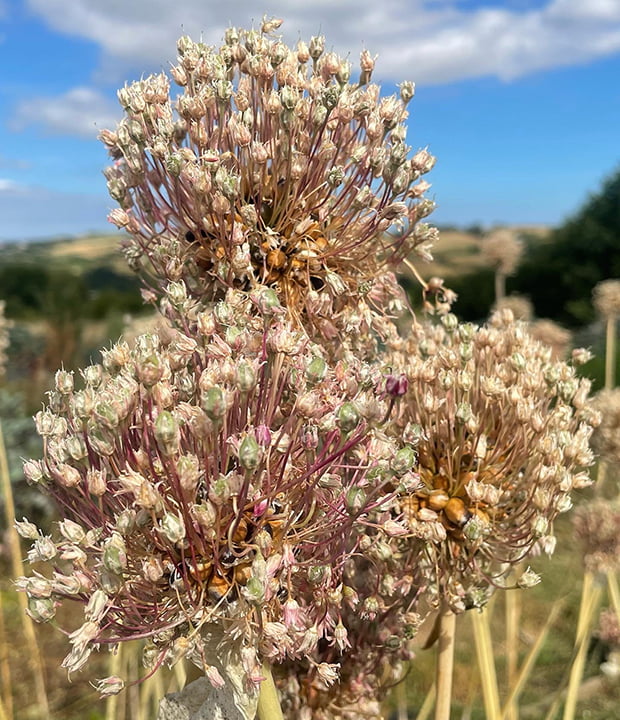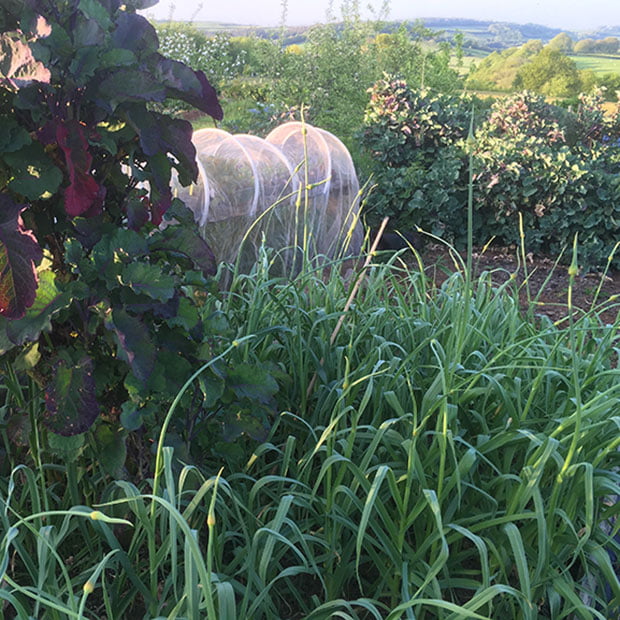Poireau perpétuel perennial leek Bulbils 5g pack – special offer
£9.99
LEEK BULBILS – SPECIAL OFFER 5 GRAM PACK FOR £9.99 (USUALLY £15)
A fantastic perennial leek that grows into a good sized leek with excellent pest resistance. Larger than a Babington leek. Harvest by cutting at ground level every year in spring/summer and watch your leeks emerge again over the winter. We will send these on as soon as they have been harvested, expected in September. 5 grams is approximately 50 bulbils or more.
Awaiting Re-stock
We can email you when it's back ...
Description
Poireau perpétuel ( Allium ampeloprasum var bulbiferum) are one of the tastiest, low maintenance and easy to grow perennial vegetables providing a yearly harvest of slender leeks with a hint of garlic. Supplied as 5g approximately 50 bulbils – (each bulbil will produce a leek plant). They can be sown direct or can be sown in pots and transplanted later when signs of shoots appear. Sow any time between autumn and spring. Poireau perpétuel leeks can be harvested by cutting the leek at the base and leaving the bulb in the ground to re-grow. Depending on your location and climate leeks can emerge from early winter through to early spring. Very hardy. Full growing instructions below. Leeks will go dormant in the hotter months and re-emerge in the autumn, this is part of their natural life cycle. Please note: bulbils are not the same as bulbs. Bulbils are small and tear drop shaped and grow in a cluster on top of the leek stem. They are produced asexually ( vegetative reproduction) and are clones of the parent plant. Please see the third picture for an idea of the size of the bulbils you are purchasing.
About
Poireau perpétuel perennial leek (Allium Ampeloprasum) is one of the tastiest and easy to grow perennial vegetables. Poireau perpétuel is similar to a Babington but produces a larger and thicker leek. Our original bulbils came to us in 2016 from Anni Kelsey ( author of ‘Edible Perennial Gardening, Growing Successful Polycultures in Small Spaces’.) Anni passed the bulbils on to us to grow on so we could offer them for sale. Although they are widely grown in France, they are not easy to find in the UK so we are really pleased to offer them for the first time. They are extremely low maintenance and ideal for polyculture spaces as they will thrive between other plants and can tolerate a range of soils and positions.
Grow
Sow any time between autumn and spring. When your bulbils arrive you can sow direct about 2cm deep allowing 8-10cm space between each bulbil. Alternatively you can sow the bulbils in a roomy pot and just leave outside. Once they have emerged you can carefully separate out the sprouted bulbils and plant them as above.
If sowing direct, mark where you have sown them so you can look out for growth appearing. The first appearance of Poireau perpétuel leek shoots can vary depending on your local climate and region from early winter to early spring.
Harvest
Simply cut the leeks at the base and leave the bulbs in the ground to re-grow. Harvesting time is usually March to June.
Propagating more plants
Poireau perpétuel perennial leeks are so tasty that you will want to harvest them all, but if you want to increase your stock quickly you need to let some of them flower. The leeks will throw up a very tall stem around July time with very attractive purple flowers. These in turn go on to produce a head of bulbils, each bulbil producing a new leek. The head will naturally bend and plant itself or you can gather bulbils and separate them when the cases are papery and sow in a new spot. As the plants mature, they produce a very large underground bulb with a cluster of ‘mini bulbs’ or offsets which will form clumps of new growth above ground. You can lift and separate and move bulbs around when they are in their dormant stage. You will find leeks popping up in strange places as bulbils sometimes get flung a distance, but it is exciting when that happens! It takes patience to establish a Poireau perpétuel colony, but well worth it and you will have them forever.
Life Cycle
The life cycle of the leeks is: Emerge in early winter, harvesting period March to June, flowers emerge July to August ( from plants that have not been cut for harvesting), heads of bulbils can be collected in August, plants then go into a period of dormancy and all top growth will disappear until moisture returns. As each year passes the underground bulbs become larger. Timing of growth/flowering cycle may vary according to your location and temperature. Sometimes the heads of bulbils will not form until the second year when the plants have become more established.
Cooking and eating
Poireau perpétuel flowers, stems, bulbs and bulbils are all edible. The leeks have a deep savoury taste and make the most delicious base for soups, are great in omelettes, or just simply sautéed in a pan. They have a garlicky hit too which just adds to their many culinary uses.











